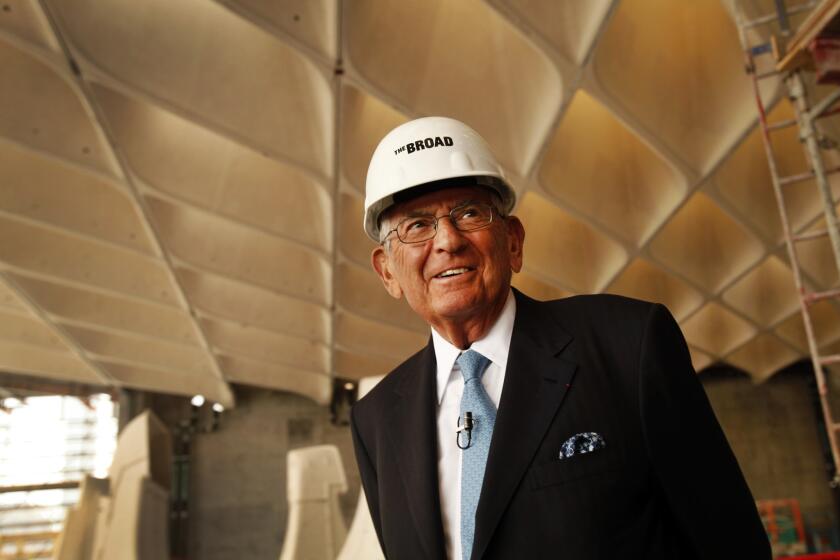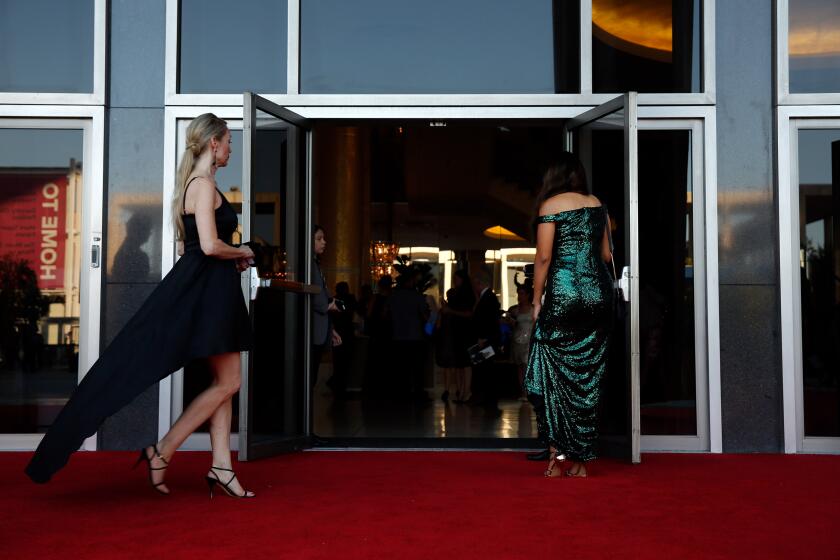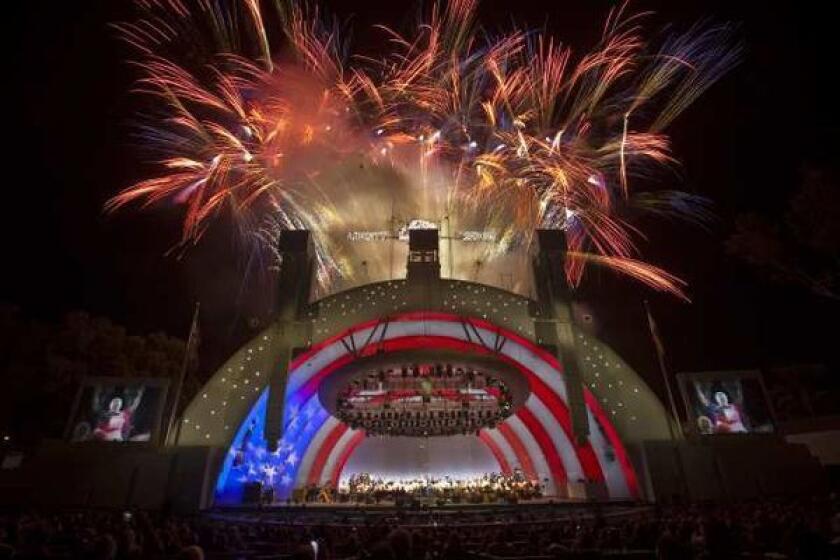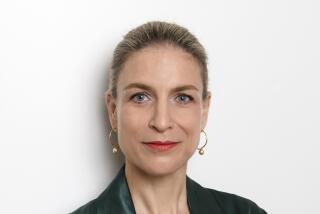The MOCA mystery: Who will be in charge of L.A.’s beloved art museum?

As the Museum of Contemporary Art prepares to reopen after a historic pandemic closure, it finds itself in the midst of restructuring, moving director Klaus Biesenbach into the role of artistic director and hiring an executive director to co-run the institution with him.
But The Times has spoken with more than two dozen people including current and former MOCA employees, artists, curators and executives at other museums, and the majority were skeptical of the dual leadership model. Some said two cooks in the kitchen would inevitably lead to conflict; others questioned whether the unusual structure is something of a smokescreen — if, in fact, MOCA is demoting Biesenbach to a role similar to chief curator. Will the new executive director really be holding the reins at the institution, which has seen four directors in 13 years?
“There’s something going on,” said artist Lari Pittman, who resigned from the MOCA board in 2018. “If someone’s doing a great job, you don’t reshuffle the job. But MOCA doesn’t have the luxury to fire anybody at that level right now. There’s a history of firing there — both chief curators and directors — and another major firing would not have gone over well. It’s the optics. Their only choice was to give him a new job description.”
Others, however, said two directors would bring double the brain power to the museum’s leadership, and that Biesenbach’s new role played to his strengths.
The Getty Center and the Broad museum are open! Here is our May guide to the most promising exhibitions across Southern California.
MOCA did not respond to multiple requests for comment for this story.
It’s a critical moment for the museum. After a COVID-19 closure lasting more than a year, MOCA reopens its Grand Avenue location to members next week and to the public on June 3. Like other cultural institutions, it faces a growing call to better address diversity, equity and inclusion within its staff and in its collections. Several key employees recently departed, one citing resistance to a diversity initiative, another a hostile work culture. MOCA’s revenue in the 2019-20 fiscal year dropped 26% and its membership 32%. Though the endowment is at a high point — $150 million — the museum has said that with governmental support limited, it’s heavily reliant on private fundraising.
The restructuring of the director role, the museum has said, is an attempt to steady the institution and to adapt to the myriad needs of the times. “The singular role of one director to oversee [every aspect of] a museum of our size,” MOCA said in a Feb. 11 email to staff, “cannot best further our mission and serve our community and team.”
Biesenbach, who has been director since fall 2018, will steer the artistic vision of the museum, including exhibitions, programming and the collections, the museum said. The curatorial staff, however, will report to the new executive director, who also will oversee daily management and operations of the finance, advancement, education, communications and human resources departments, as well as key initiatives such as the museum’s new IDEA effort, promoting inclusion, diversity, equity and accessibility. Both leaders will fundraise.
But questions abound: Who, ultimately, controls the budget? Who has final say over the exhibition schedule, particularly if curatorial does not roll up to Biesenbach? Will Biesenbach take a pay cut? His full salary is not available on the museum’s most recent public tax filing (for fiscal year 2018-19), but his predecessor, Philippe Vergne, earned about $709,000. Will the two directors’ salaries be equal?
Or, more simply, as some staffers are asking: “Who’s in charge?”
“It feels like another big boss, but what does that mean?” said one employee who asked to remain anonymous because the person was not authorized to speak to media. “And is it necessary? I think people are confused, to say the least.”
Several people were surprised that the executive director, not Biesenbach, will assume responsibility for the curatorial department.
“If this were all about a separation between the artistic vision and the managerial aspects of the museum, then it could work,” said Selma Holo, executive director of USC Museums. “But I’m troubled by the fact that curatorial will report to the executive director. Because then, in fact, Biesenbach does not have control over the artistic vision. There’s an illogic about it.”
Mark Bradford won’t forget his “funny handshake.” Liz Diller called him “curmudgeonly generous.” Artists, architects and museum directors share their memories of Eli Broad.
An official job description might clarify plans, but MOCA declined to share one with The Times. (Museums often don’t publicly post senior-level job openings, but some do.) MOCA hired the consulting firm Spencer Stuart to fill the executive director position, but the firm declined to comment.
All of which has left many concerned that the dual leadership structure will be problematic.
“If you’re not in charge of the budget and human resources at the museum, then you’re not in charge of the museum,” said Paul Schimmel, former chief curator at MOCA. “It has not worked at other institutions both large and small, and the ability to attract the best and brightest will be greatly affected by the fact that they are dividing the singular leadership role of MOCA.”
One concern among some MOCA staffers is the stress that two director salaries could put on museum finances — particularly after MOCA laid off 97 part-time employees at the start of the pandemic and 69 full-time staffers took full or partial furloughs or salary reductions. Biesenbach, the museum said, took the largest pay cut at the time. As of September, all furloughed full-time employees had returned to work. Some part-time and temporary staffers returned to work as well.
The financial sacrifices made by staff during the pandemic may also bring more scrutiny to the museum’s recent spate of acquisitions. In an attempt to diversify its permanent collection with more works by women and BIPOC artists, the museum acquired during the pandemic more than 100 artworks, a mix of gifts and purchases.
Another concern: Equal directors reporting to the board gives chair Maria Seferian an all-powerful tie-breaking role, should the directors’ visions be at odds.
“I like Maria Seferian; she’s incredibly smart and capable and she’s done incredible work,” Pittman said. “But she’s not ready to run a museum. She’s a lawyer.”
Others are more open to the horizontal leadership model, especially considering all of MOCA’s directors thus far have been white men and the museum has faced criticism over lack of diversity and inclusion. Museums employ “hierarchical structures based on patriarchal notions,” said Emma Reeves, former creative director of MOCA TV, who’s now a brand consultant focusing on equitable hiring practices. The new model, she said, could promote diversity at MOCA’s helm.
“I’m all for change and different structures,” Reeves said. “I like the idea of two human beings in charge who could divide and conquer and actually pull something off — but situations are complex and humans are fallible. I’d love to know more: Is this because they want a more inclusive hire at the top? I’d hope so. Change has to come from the top.”
L.A. Opera moves its outdoor “Oedipus Rex” into the Dorothy Chandler Pavilion, making it the first major L.A. arts group to stage an indoor show.
The restructuring could be pioneering, said former MOCA board chair and life trustee Maria Bell.
“It’s not uncommon for a creative and visionary to not enjoy the business side,” Bell said. “This model is something I think more museums might be open to in the future. There’s nothing wrong with it as long as people can work together as a team. It can be a huge positive and a much more efficient way to run a museum.”
Dual leadership is not unheard-of in the museum world. At the Metropolitan Museum of Art in New York, Daniel H. Weiss serves as president and chief executive, responsible for “overall leadership” at the museum, while Max Hollein serves as director, responsible for the “core mission functions.” But they are not equals: Hollein reports to Weiss.
The Los Angeles County Museum of Art has had stints of dual leadership over the years. Director and Chief Executive Michael Govan worked alongside President and Chief Operating Officer Melody Kanschat until she retired in 2011 — but she reported to him. In 1995 Andrea Rich was hired as president and CEO, and a year later Graham Beal joined her as director and executive vice president — but he reported to her.
The dual-leader model is more common in Britain, where at the Serpentine, for example, Bettina Korek is chief executive and Hans Ulrich Obrist artistic director; they both report to the board.
It’s far more common to see dual leadership in the performing arts, particularly among organizations creating original work, said Lisa Richards Toney, president of the Assn. of Performing Arts Professionals.
“While each organization’s structure or culture may necessitate varying the weight or reporting structure for the artistic director or the executive director, in most cases, the positions are equal on the organizational chart,” she said, adding that L.A.’s Center Theatre Group and Dance Theatre of Harlem employ dual leadership models.
Adrienne Horn, president of San Francisco-based Museum Management Consultants, said that dual leadership at museums has upsides and challenges.
“The good news is that when you have a director who is strictly dealing with the artistic side, there’s a deep emphasis on that, with expertise, and the other director would have more of a business acumen,” she said. “But in the end, is there any real boss except for the board? We’ll see how it works at MOCA.
“The ultimate question is: How will they work together for the betterment of the organization?”
Vaccinated people will get 85% of the tickets for the Bowl’s 2021 season, which includes Christina Aguilera, Yo-Yo Ma and “Black Panther” live.
More to Read
The biggest entertainment stories
Get our big stories about Hollywood, film, television, music, arts, culture and more right in your inbox as soon as they publish.
You may occasionally receive promotional content from the Los Angeles Times.














